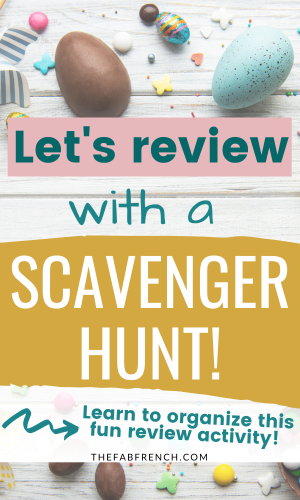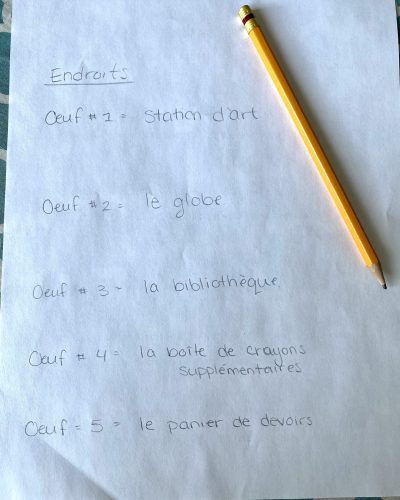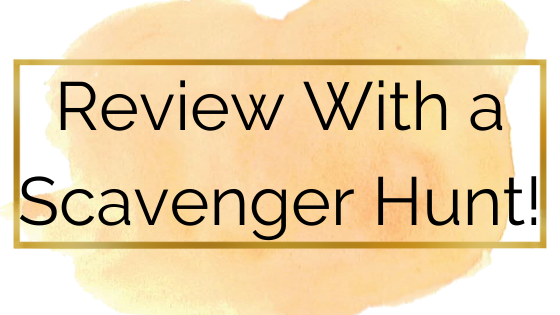Let’s do a review scavenger hunt!
Whether you teach younger students or older students, you can have some fun with the different holidays that some students may celebrate throughout the year.
Often for our younger kiddos we focus on vocabulary acquisition for the themed activities, which is an obvious way to incorporate these events into our lessons. However, our older kiddos often just need a quick review, or sometimes not at all.
So, how do you have some fun with them around these theme-based holidays??
Find ways to incorporate them authentically and relate them to other topics you’re covering.
Case in point: Review scavenger hunts!
Now, what do I mean by that?
I’ll walk you through it.

What does it look like?
The overall idea of this is that you buy some plastic Easter egg shells from the dollar store, stuff them with clues (related to anything!), and hide them around your room.
Of course, you need to make sure that each clue leads to the next and I recommend having an answer sheet, but we’ll get to that later.
Step 1:
First off, you need to decide what content you want them to practice. I often do this activity to do verb conjugation review. On each slip of paper I can put the subject and the infinitive verb, and then the students write their conjugation on their answer sheet.
Ideas for topics:
Verbes
Classes de mots
Synonymes/antomynes
Mathématiques
Révision de science
Révision d’études sociales
You can choose almost anything as long as you can put a question in the egg that can be answered on whatever answer sheet you prepare.
Step 2:
Prepare your questions and answers in advance. Decide how many eggs you want to have (I recommend a minimum of enough for half your class size). I recommend typing everything out in a document so that you can easily print and cut the questions when you’re ready.
With younger kiddos, I would create an answer sheet on which the kiddos write their answers so that it’s easy for them to understand and follow. For older students I typically just have them write their answers on a lined sheet of paper.
Here’s an example:

Step 3:
Now that you have all your questions, you need to include your clues/directions. Each piece of paper with a question also needs either a clue or directions that lead the students to the next egg. For younger kiddos, I would probably do directions, and for older kiddos, I would do clues. This is a great way to incorporate themed vocabulary if you bring/have any type of decorations in your space.
Exemple
Question: Conjugue le verbe “vieillir” à la 3e personne singulier au passé composé.
Indice: Le prochain oeuf se trouve …
Step 4:
Now things get a little complicated and confusing.
Start by printing 2 copies of your questions/hints page. Before you cut each one, I recommend flipping to the backside of the page and lightly writing the location for that clue in pencil. To figure this out, you look at the previous directions/hint since that’s the one that would lead to that question.
Take a look here:


Step 5:
Now that everything is organized, cut out each question/hint combo on one of your printed copies. Unfortunately, I recommend putting each egg together and in its spot one at a time so that you don’t get mixed up.
Take your first clue, check where it needs to be placed (which you wrote in pencil on the back), put the clue in the egg, and hide the egg in its spot. Take the next clue and continue this until all clues are in their spots.
Now you have all your eggs in their hiding spots, and you have an extra copy which is like an answer key so that you can troubleshoot any issues. Now you’re ready for your review scavenger hunt!
It’s a bit of a process the first time you do it but once you’ve done it once, I promise it gets easier. And the kiddos LOVE it!
If you are interested in more ways to incorporate themed vocabulary into your classroom, check this out: Teaching Themed Vocabulary Without Explicitly Teaching Themed Vocabulary

